power steering BMW Z4 3.0SI ROADSTER 2007 E85 Owner's Manual
[x] Cancel search | Manufacturer: BMW, Model Year: 2007, Model line: Z4 3.0SI ROADSTER, Model: BMW Z4 3.0SI ROADSTER 2007 E85Pages: 132, PDF Size: 3.14 MB
Page 15 of 132
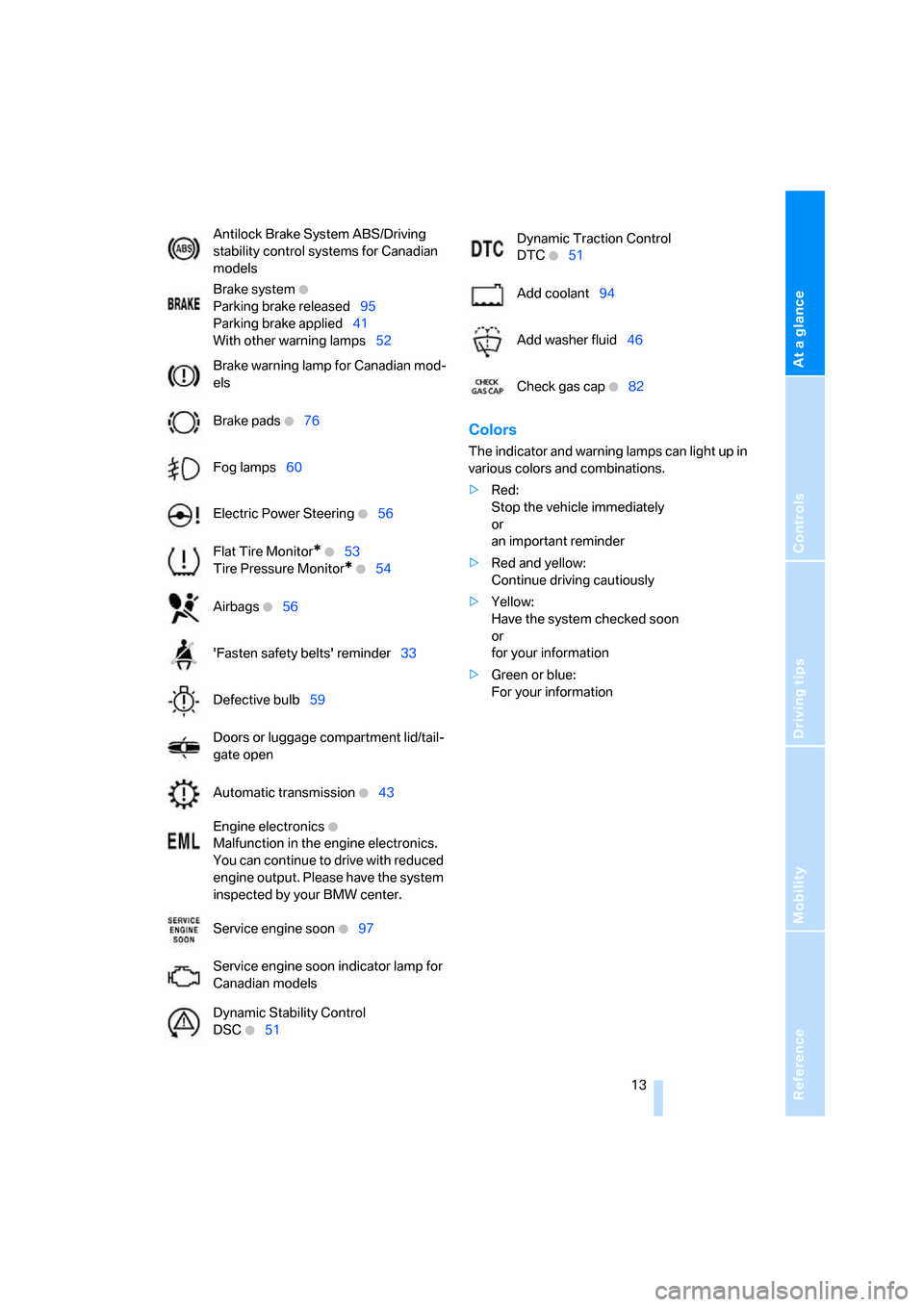
At a glance
Controls
Driving tips
Mobility Reference
13
Colors
The indicator and warning lamps can light up in
various colors and combinations.
>Red:
Stop the vehicle immediately
or
an important reminder
>Red and yellow:
Continue driving cautiously
>Yellow:
Have the system checked soon
or
for your information
>Green or blue:
For your information Antilock Brake System ABS/Driving
stability control systems for Canadian
models
Brake system
+
Parking brake released95
Parking brake applied41
With other warning lamps52
Brake warning lamp for Canadian mod-
els
Brake pads
+76
Fog lamps60
Electric Power Steering
+56
Flat Tire Monitor
* +53
Tire Pressure Monitor
* +54
Airbags
+56
'Fasten safety belts' reminder33
Defective bulb59
Doors or luggage compartment lid/tail-
gate open
Automatic transmission
+43
Engine electronics
+
Malfunction in the engine electronics.
You can continue to drive with reduced
engine output. Please have the system
inspected by your BMW center.
Service engine soon
+97
Service engine soon indicator lamp for
Canadian models
Dynamic Stability Control
DSC
+51
Dynamic Traction Control
DTC
+51
Add coolant94
Add washer fluid46
Check gas cap
+82
Page 46 of 132
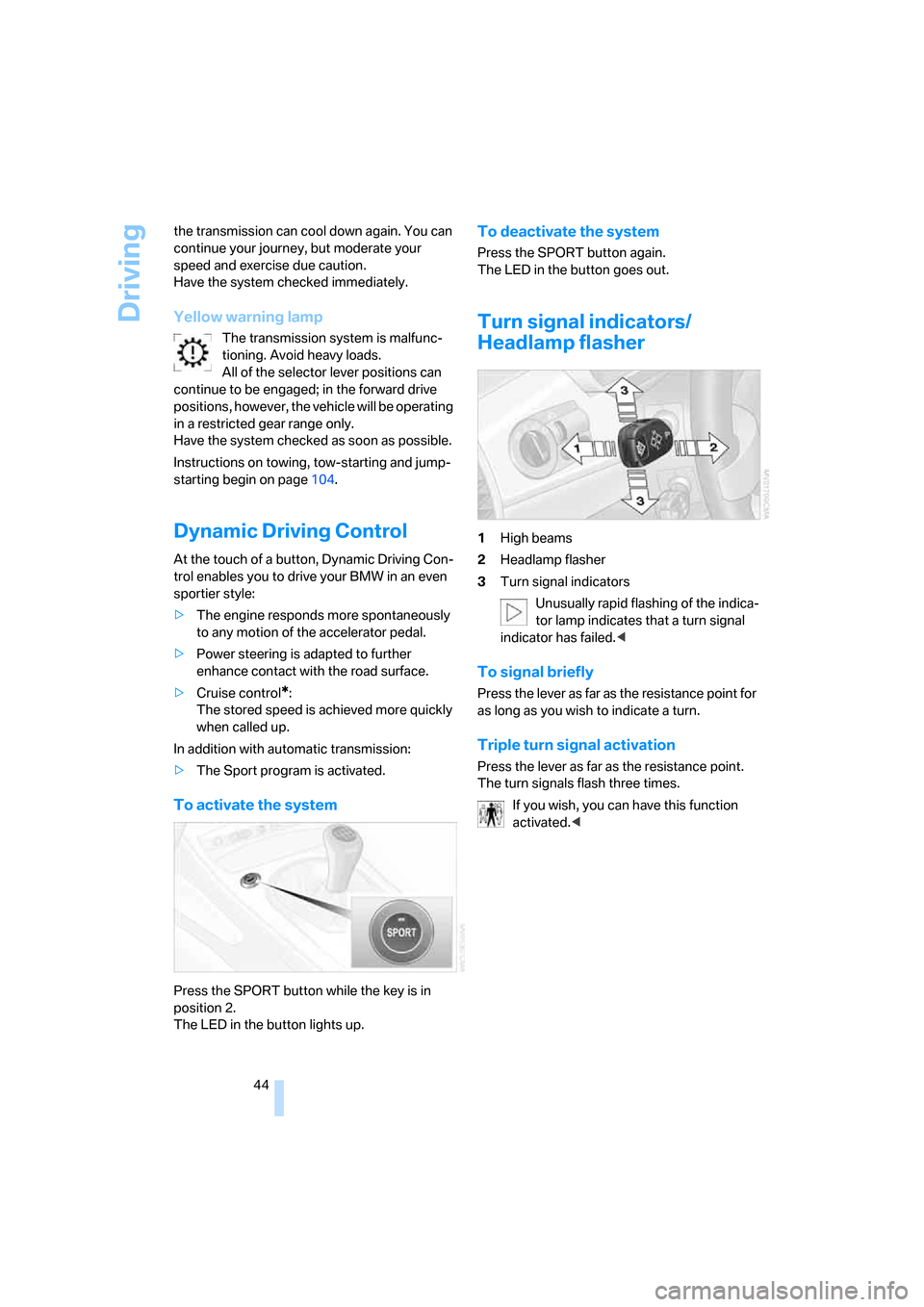
Driving
44 the transmission can cool down again. You can
continue your journey, but moderate your
speed and exercise due caution.
Have the system checked immediately.
Yellow warning lamp
The transmission system is malfunc-
tioning. Avoid heavy loads.
All of the selector lever positions can
continue to be engaged; in the forward drive
positions, however, the vehicle will be operating
in a restricted gear range only.
Have the system checked as soon as possible.
Instructions on towing, tow-starting and jump-
starting begin on page104.
Dynamic Driving Control
At the touch of a button, Dynamic Driving Con-
trol enables you to drive your BMW in an even
sportier style:
>The engine responds more spontaneously
to any motion of the accelerator pedal.
>Power steering is adapted to further
enhance contact with the road surface.
>Cruise control
*:
The stored speed is achieved more quickly
when called up.
In addition with automatic transmission:
>The Sport program is activated.
To activate the system
Press the SPORT button while the key is in
position 2.
The LED in the button lights up.
To deactivate the system
Press the SPORT button again.
The LED in the button goes out.
Turn signal indicators/
Headlamp flasher
1High beams
2Headlamp flasher
3Turn signal indicators
Unusually rapid flashing of the indica-
tor lamp indicates that a turn signal
indicator has failed.<
To signal briefly
Press the lever as far as the resistance point for
as long as you wish to indicate a turn.
Triple turn signal activation
Press the lever as far as the resistance point.
The turn signals flash three times.
If you wish, you can have this function
activated.<
Page 58 of 132
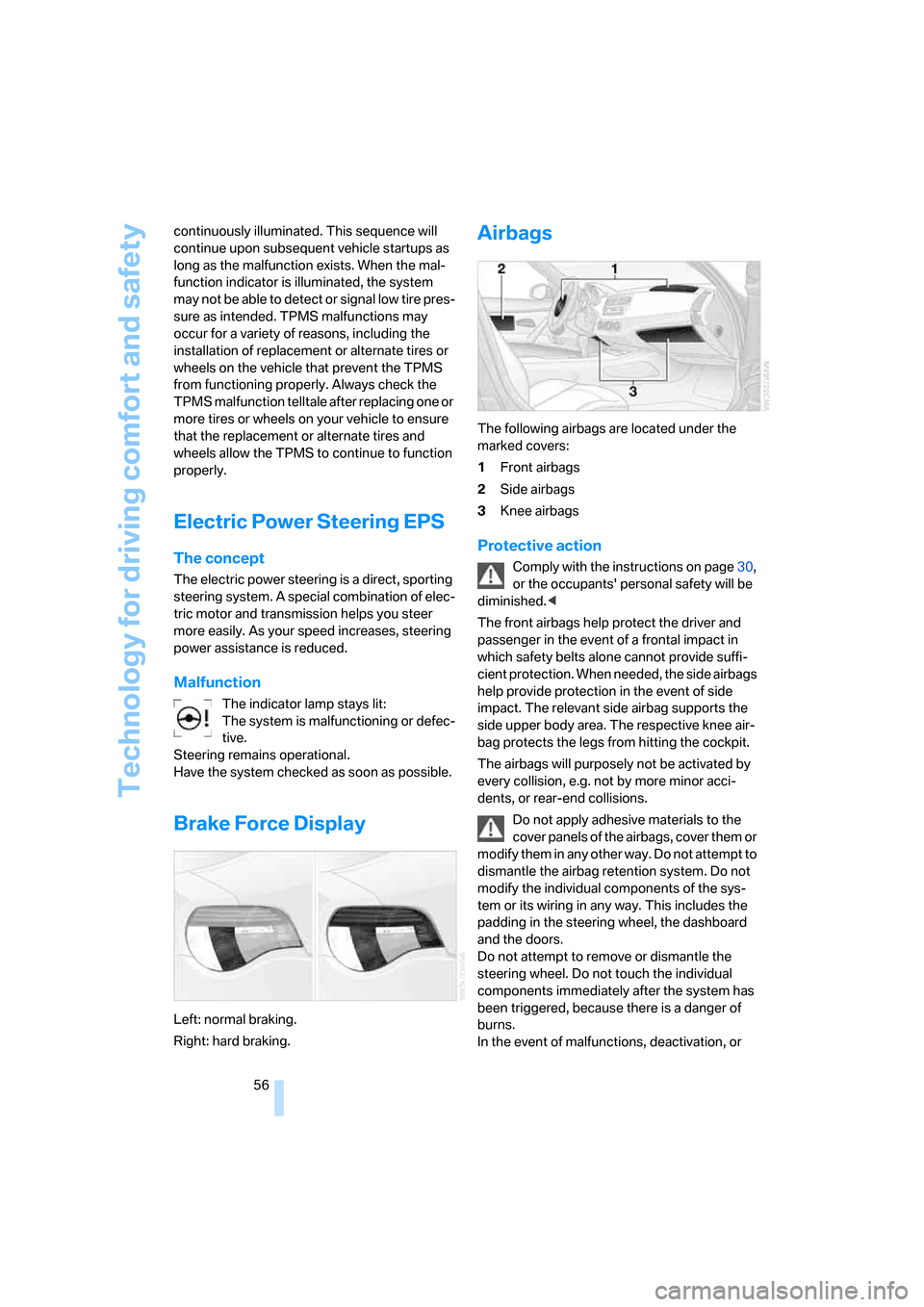
Technology for driving comfort and safety
56 continuously illuminated. This sequence will
continue upon subsequent vehicle startups as
long as the malfunction exists. When the mal-
function indicator is illuminated, the system
may not be able to detect or signal low tire pres-
sure as intended. TPMS malfunctions may
occur for a variety of reasons, including the
installation of replacement or alternate tires or
wheels on the vehicle that prevent the TPMS
from functioning properly. Always check the
TPMS malfunction telltale after replacing one or
more tires or wheels on your vehicle to ensure
that the replacement or alternate tires and
wheels allow the TPMS to continue to function
properly.
Electric Power Steering EPS
The concept
The electric power steering is a direct, sporting
steering system. A special combination of elec-
tric motor and transmission helps you steer
more easily. As your speed increases, steering
power assistance is reduced.
Malfunction
The indicator lamp stays lit:
The system is malfunctioning or defec-
tive.
Steering remains operational.
Have the system checked as soon as possible.
Brake Force Display
Left: normal braking.
Right: hard braking.
Airbags
The following airbags are located under the
marked covers:
1Front airbags
2Side airbags
3Knee airbags
Protective action
Comply with the instructions on page30,
or the occupants' personal safety will be
diminished.<
The front airbags help protect the driver and
passenger in the event of a frontal impact in
which safety belts alone cannot provide suffi-
cient protection. When needed, the side airbags
help provide protection in the event of side
impact. The relevant side airbag supports the
side upper body area. The respective knee air-
bag protects the legs from hitting the cockpit.
The airbags will purposely not be activated by
every collision, e.g. not by more minor acci-
dents, or rear-end collisions.
Do not apply adhesive materials to the
cover panels of the airbags, cover them or
modify them in any other way. Do not attempt to
dismantle the airbag retention system. Do not
modify the individual components of the sys-
tem or its wiring in any way. This includes the
padding in the steering wheel, the dashboard
and the doors.
Do not attempt to remove or dismantle the
steering wheel. Do not touch the individual
components immediately after the system has
been triggered, because there is a danger of
burns.
In the event of malfunctions, deactivation, or
Page 77 of 132

Reference
At a glance
Controls
Driving tips
Mobility
75
cannot be ruled out that vehicle electronics and
the mobile communications device interfere
with one another. In addition, it is not ensured
that the radio waves emitted during transmis-
sion are directed outside of the vehicle inte-
rior.<
Hydroplaning
When driving on wet or slushy roads,
reduce vehicle speed. If you do not, a
wedge of water may form between the tires and
the road surface. This situation, known as
hydroplaning, means that the tire can com-
pletely lose contact with the road surface, so
that neither the car can be steered nor the brake
be properly applied.<
The risk of hydroplaning increases with declin-
ing tread depth on the tires, refer also to Mini-
mum tread depth on page87.
Driving through water
Drive through water on the road only if it is
not deeper than 1 ft/30 cm, and then only
at walking speed at the most. Otherwise, the
vehicle's engine, the electrical systems and the
transmission may be damaged.<
Moisture inside the vehicle
Make sure that the passenger compart-
ment does not become wet and that liq-
uids are transported in closed containers.
Otherwise, moisture could penetrate and dam-
age electronic components inside the vehicle.<
Use the parking brake on inclines
On inclines, keep the vehicle from rolling
by using the parking brake rather than by
slipping the clutch, which would lead to a high
degree of clutch wear.<
Braking safely
Your BMW is equipped with ABS as a standard
feature. Applying the brakes fully is the most
effective way of braking in situations in which
this is necessary. Since the vehicle maintains
steering responsiveness, you can still avoid possible obstacles with a minimum of steering
effort.
Pulsation at the brake pedal combines with
sounds from the hydraulic circuits to indicate to
the driver that ABS is in its active mode.
Wet roads
When roads are wet or there is heavy rain,
briefly exert gentle pressure on the brake pedal
every few miles. Watch traffic conditions to
ensure that this maneuver does not endanger
other road users. The resulting heat dries the
brake rotors and brake pads. Immediate braking
force is then available if necessary.
Inclines
To prevent overheating and, as a result,
diminished braking effectiveness, drive
down long or steep downhill grades in the gear
that requires the least braking. Otherwise, even
light but consistent pedal pressure can lead to
high temperatures, brake wear and possibly
even brake failure.<
You can increase the engine's braking effect by
shifting down, all the way to first gear if neces-
sary. This strategy helps you avoid placing
excessive loads on the brake system. Down-
shifting in manual mode of the automatic trans-
mission, refer to page43.
Never drive with the clutch held down,
with the transmission in idle or with the
engine switched off; otherwise, engine braking
action will not be present or there will be no
power assistance to the brakes or steering.
Never allow floor mats, carpets or any other
objects to protrude into the area around the
pedals, otherwise pedal function could be
impaired.<
Corrosion on the brake rotors
Limited vehicle use, extended periods with the
vehicle parked or in storage, and operating con-
ditions in which braking is restricted to gentle,
low-pressure applications will all increase the
tendency for corrosion to form on the rotors and
contamination to accumulate on the brake
pads. This occurs because the minimal pres-
Page 104 of 132
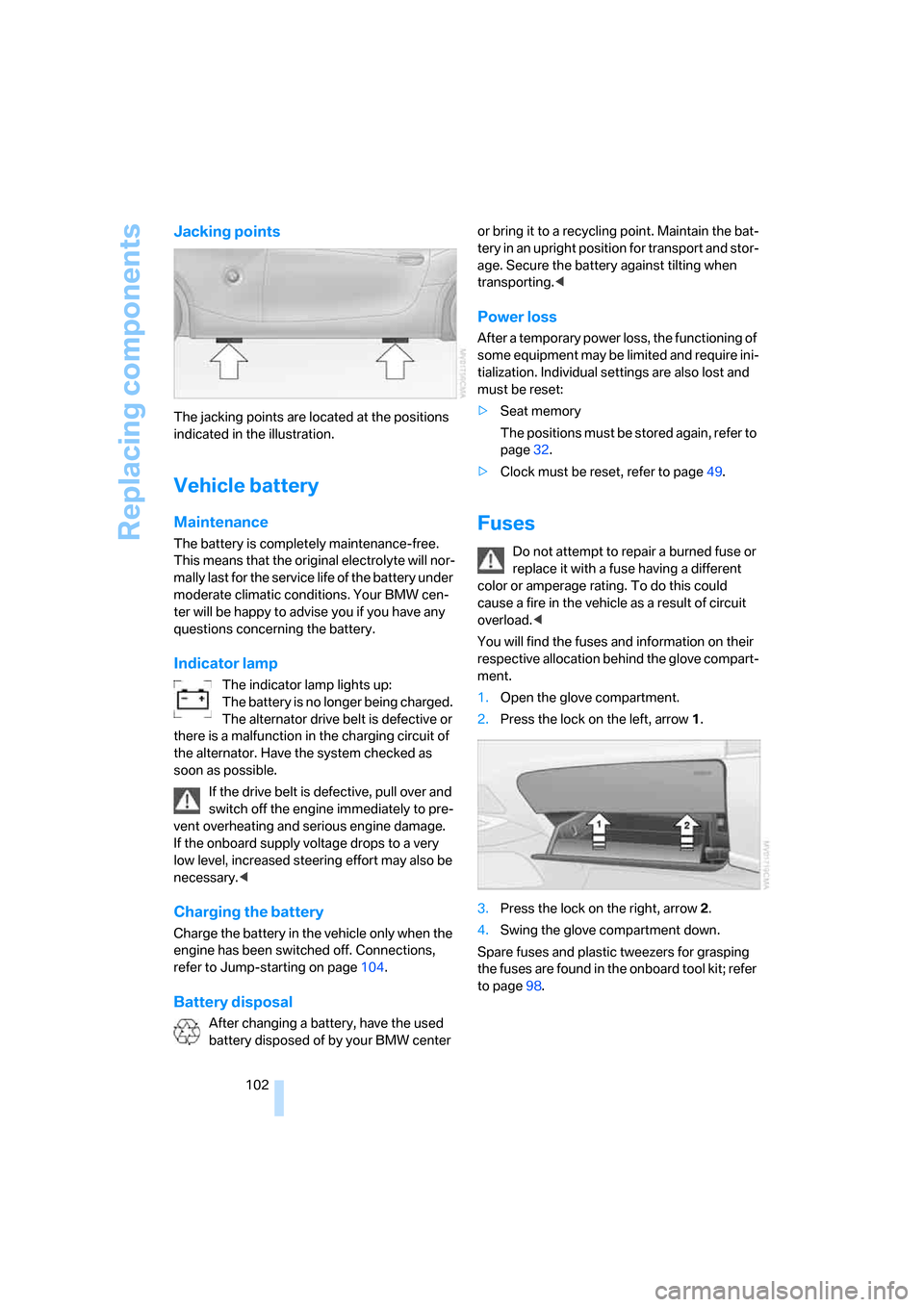
Replacing components
102
Jacking points
The jacking points are located at the positions
indicated in the illustration.
Vehicle battery
Maintenance
The battery is completely maintenance-free.
This means that the original electrolyte will nor-
mally last for the service life of the battery under
moderate climatic conditions. Your BMW cen-
ter will be happy to advise you if you have any
questions concerning the battery.
Indicator lamp
The indicator lamp lights up:
The battery is no longer being charged.
The alternator drive belt is defective or
there is a malfunction in the charging circuit of
the alternator. Have the system checked as
soon as possible.
If the drive belt is defective, pull over and
switch off the engine immediately to pre-
vent overheating and serious engine damage.
If the onboard supply voltage drops to a very
low level, increased steering effort may also be
necessary.<
Charging the battery
Charge the battery in the vehicle only when the
engine has been switched off. Connections,
refer to Jump-starting on page104.
Battery disposal
After changing a battery, have the used
battery disposed of by your BMW center or bring it to a recycling point. Maintain the bat-
tery in an upright position for transport and stor-
age. Secure the battery against tilting when
transporting.<
Power loss
After a temporary power loss, the functioning of
some equipment may be limited and require ini-
tialization. Individual settings are also lost and
must be reset:
>Seat memory
The positions must be stored again, refer to
page32.
>Clock must be reset, refer to page49.
Fuses
Do not attempt to repair a burned fuse or
replace it with a fuse having a different
color or amperage rating. To do this could
cause a fire in the vehicle as a result of circuit
overload.<
You will find the fuses and information on their
respective allocation behind the glove compart-
ment.
1.Open the glove compartment.
2.Press the lock on the left, arrow1.
3.Press the lock on the right, arrow2.
4.Swing the glove compartment down.
Spare fuses and plastic tweezers for grasping
the fuses are found in the onboard tool kit; refer
to page98.
Page 108 of 132
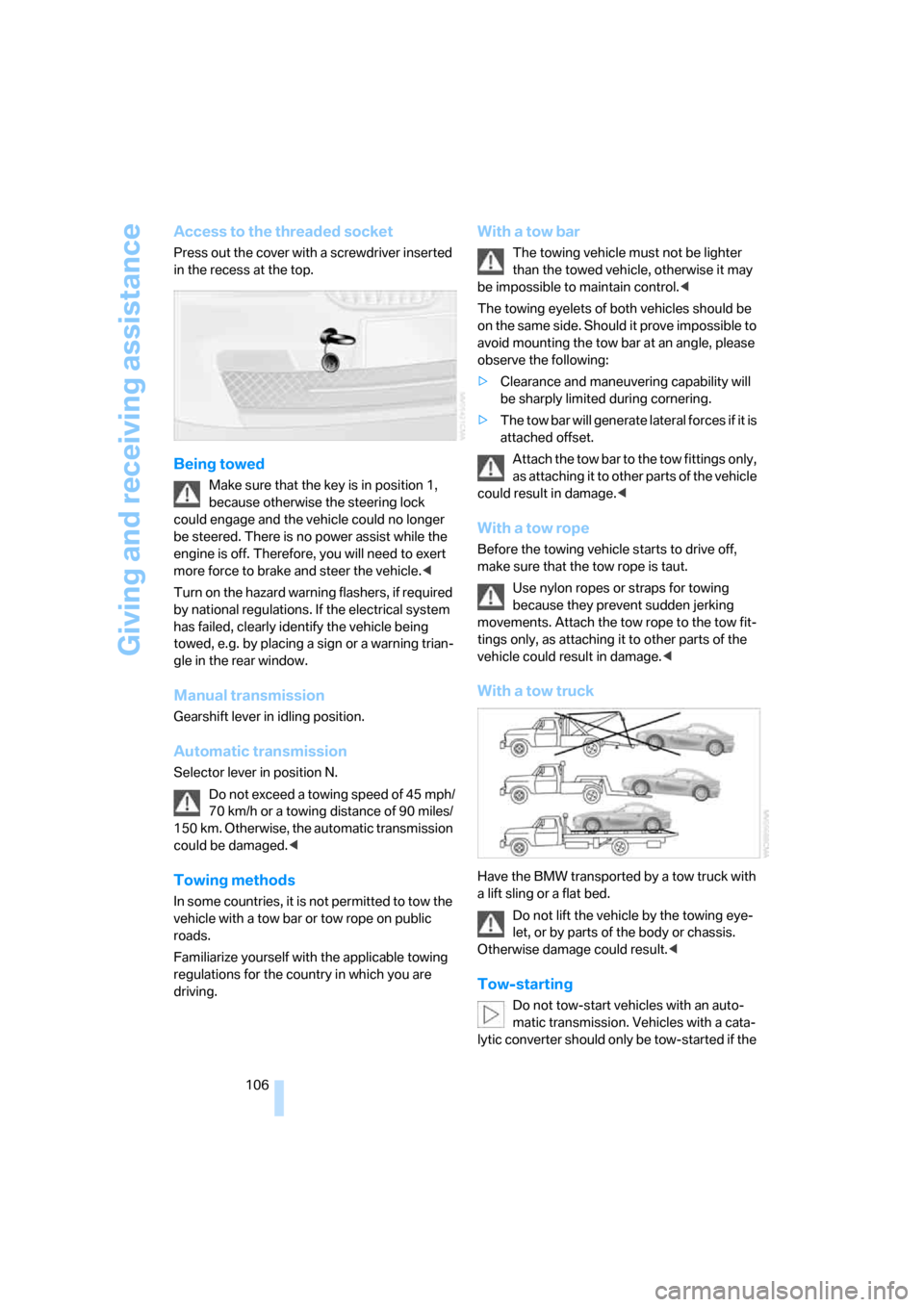
Giving and receiving assistance
106
Access to the threaded socket
Press out the cover with a screwdriver inserted
in the recess at the top.
Being towed
Make sure that the key is in position 1,
because otherwise the steering lock
could engage and the vehicle could no longer
be steered. There is no power assist while the
engine is off. Therefore, you will need to exert
more force to brake and steer the vehicle.<
Turn on the hazard warning flashers, if required
by national regulations. If the electrical system
has failed, clearly identify the vehicle being
towed, e.g. by placing a sign or a warning trian-
gle in the rear window.
Manual transmission
Gearshift lever in idling position.
Automatic transmission
Selector lever in position N.
Do not exceed a towing speed of 45 mph/
70 km/h or a towing distance of 90 miles/
150 km. Otherwise, the automatic transmission
could be damaged.<
Towing methods
In some countries, it is not permitted to tow the
vehicle with a tow bar or tow rope on public
roads.
Familiarize yourself with the applicable towing
regulations for the country in which you are
driving.
With a tow bar
The towing vehicle must not be lighter
than the towed vehicle, otherwise it may
be impossible to maintain control.<
The towing eyelets of both vehicles should be
on the same side. Should it prove impossible to
avoid mounting the tow bar at an angle, please
observe the following:
>Clearance and maneuvering capability will
be sharply limited during cornering.
>The tow bar will generate lateral forces if it is
attached offset.
Attach the tow bar to the tow fittings only,
as attaching it to other parts of the vehicle
could result in damage.<
With a tow rope
Before the towing vehicle starts to drive off,
make sure that the tow rope is taut.
Use nylon ropes or straps for towing
because they prevent sudden jerking
movements. Attach the tow rope to the tow fit-
tings only, as attaching it to other parts of the
vehicle could result in damage.<
With a tow truck
Have the BMW transported by a tow truck with
a lift sling or a flat bed.
Do not lift the vehicle by the towing eye-
let, or by parts of the body or chassis.
Otherwise damage could result.<
Tow-starting
Do not tow-start vehicles with an auto-
matic transmission. Vehicles with a cata-
lytic converter should only be tow-started if the
Page 119 of 132
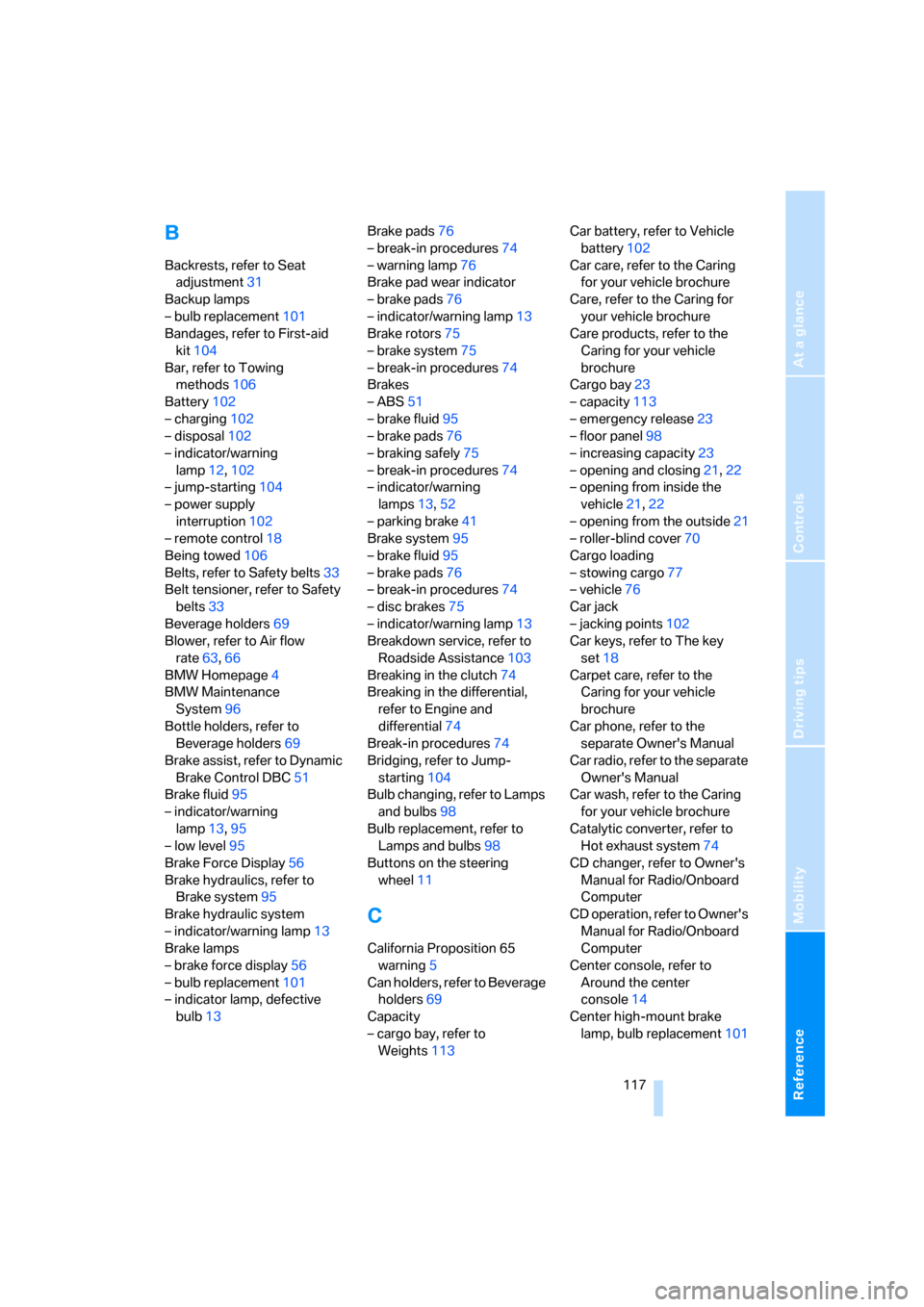
Reference
At a glance
Controls
Driving tips
Mobility
117
B
Backrests, refer to Seat
adjustment31
Backup lamps
– bulb replacement101
Bandages, refer to First-aid
kit104
Bar, refer to Towing
methods106
Battery102
– charging102
– disposal102
– indicator/warning
lamp12,102
– jump-starting104
– power supply
interruption102
– remote control18
Being towed106
Belts, refer to Safety belts33
Belt tensioner, refer to Safety
belts33
Beverage holders69
Blower, refer to Air flow
rate63,66
BMW Homepage4
BMW Maintenance
System96
Bottle holders, refer to
Beverage holders69
Brake assist, refer to Dynamic
Brake Control DBC51
Brake fluid95
– indicator/warning
lamp13,95
– low level95
Brake Force Display56
Brake hydraulics, refer to
Brake system95
Brake hydraulic system
– indicator/warning lamp13
Brake lamps
– brake force display56
– bulb replacement101
– indicator lamp, defective
bulb13Brake pads76
– break-in procedures74
– warning lamp76
Brake pad wear indicator
– brake pads76
– indicator/warning lamp13
Brake rotors75
– brake system75
– break-in procedures74
Brakes
– ABS51
– brake fluid95
– brake pads
76
– braking safely75
– break-in procedures74
– indicator/warning
lamps13,52
– parking brake41
Brake system95
– brake fluid95
– brake pads76
– break-in procedures74
– disc brakes75
– indicator/warning lamp13
Breakdown service, refer to
Roadside Assistance103
Breaking in the clutch74
Breaking in the differential,
refer to Engine and
differential74
Break-in procedures74
Bridging, refer to Jump-
starting104
Bulb changing, refer to Lamps
and bulbs98
Bulb replacement, refer to
Lamps and bulbs98
Buttons on the steering
wheel11
C
California Proposition 65
warning5
Can holders, refer to Beverage
holders69
Capacity
– cargo bay, refer to
Weights113Car battery, refer to Vehicle
battery102
Car care, refer to the Caring
for your vehicle brochure
Care, refer to the Caring for
your vehicle brochure
Care products, refer to the
Caring for your vehicle
brochure
Cargo bay23
– capacity113
– emergency release23
– floor panel98
– increasing capacity23
– opening and closing21,22
– opening from inside the
vehicle21,22
– opening from the outside21
– roller-blind cover70
Cargo loading
– stowing cargo77
– vehicle76
Car jack
– jacking points102
Car keys, refer to The key
set18
Carpet care, refer to the
Caring for your vehicle
brochure
Car phone, refer to the
separate Owner's Manual
Car radio, refer to the separate
Owner's Manual
Car wash, refer to the Caring
for your vehicle brochure
Catalytic converter, refer to
Hot exhaust system74
CD changer, refer to Owner's
Manual for Radio/Onboard
Computer
CD operation, refer to Owner's
Manual for Radio/Onboard
Computer
Center console, refer to
Around the center
console14
Center high-mount brake
lamp, bulb replacement101
Page 121 of 132
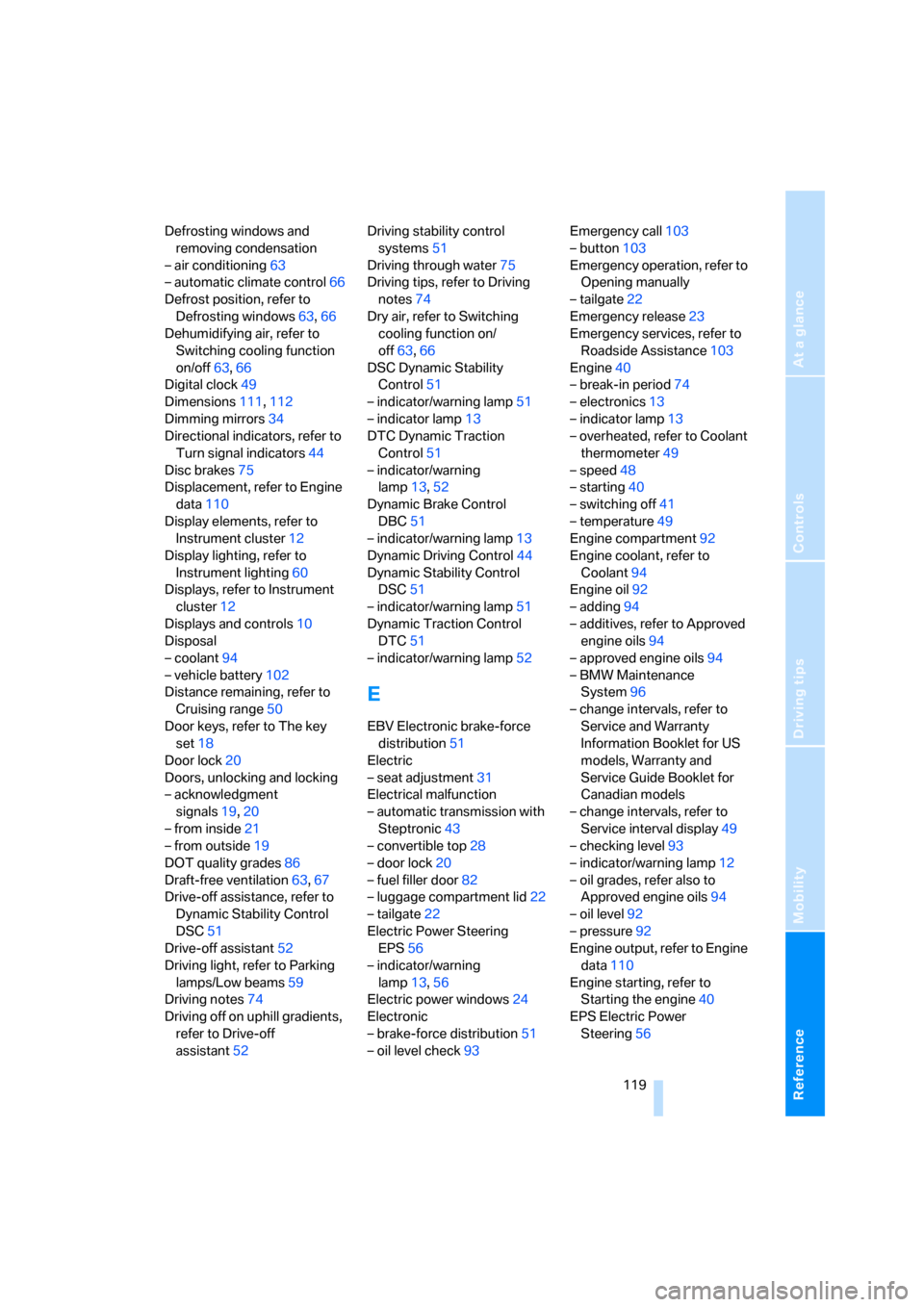
Reference
At a glance
Controls
Driving tips
Mobility
119
Defrosting windows and
removing condensation
– air conditioning63
– automatic climate control66
Defrost position, refer to
Defrosting windows63,66
Dehumidifying air, refer to
Switching cooling function
on/off63,66
Digital clock49
Dimensions111,112
Dimming mirrors34
Directional indicators, refer to
Turn signal indicators44
Disc brakes75
Displacement, refer to Engine
data110
Display elements, refer to
Instrument cluster12
Display lighting, refer to
Instrument lighting60
Displays, refer to Instrument
cluster12
Displays and controls10
Disposal
– coolant94
– vehicle battery102
Distance remaining, refer to
Cruising range50
Door keys, refer to The key
set18
Door lock20
Doors, unlocking and locking
– acknowledgment
signals19,20
– from inside21
– from outside19
DOT quality grades86
Draft-free ventilation63,67
Drive-off assistance, refer to
Dynamic Stability Control
DSC51
Drive-off assistant52
Driving light, refer to Parking
lamps/Low beams59
Driving notes74
Driving off on uphill gradients,
refer to Drive-off
assistant52Driving stability control
systems51
Driving through water75
Driving tips, refer to Driving
notes74
Dry air, refer to Switching
cooling function on/
off63,66
DSC Dynamic Stability
Control51
– indicator/warning lamp51
– indicator lamp13
DTC Dynamic Traction
Control51
– indicator/warning
lamp13,52
Dynamic Brake Control
DBC51
– indicator/warning lamp13
Dynamic Driving Control44
Dynamic Stability Control
DSC51
– indicator/warning lamp51
Dynamic Traction Control
DTC51
– indicator/warning lamp52
E
EBV Electronic brake-force
distribution51
Electric
– seat adjustment31
Electrical malfunction
– automatic transmission with
Steptronic43
– convertible top28
– door lock20
– fuel filler door82
– luggage compartment lid22
– tailgate22
Electric Power Steering
EPS56
– indicator/warning
lamp13,56
Electric power windows24
Electronic
– brake-force distribution51
– oil level check93Emergency call103
– button103
Emergency operation, refer to
Opening manually
– tailgate22
Emergency release23
Emergency services, refer to
Roadside Assistance103
Engine40
– break-in period74
– electronics13
– indicator lamp13
– overheated, refer to Coolant
thermometer49
– speed48
– starting40
– switching off41
– temperature49
Engine compartment92
Engine coolant, refer to
Coolant94
Engine oil92
– adding94
– additives, refer to Approved
engine oils94
– approved engine oils94
– BMW Maintenance
System96
– change intervals, refer to
Service and Warranty
Information Booklet for US
models, Warranty and
Service Guide Booklet for
Canadian models
– change intervals, refer to
Service interval display49
– checking level93
– indicator/warning lamp12
– oil grades, refer also to
Approved engine oils94
– oil level92
– pressure92
Engine output, refer to Engine
data110
Engine starting, refer to
Starting the engine40
EPS Electric Power
Steering56
Page 123 of 132
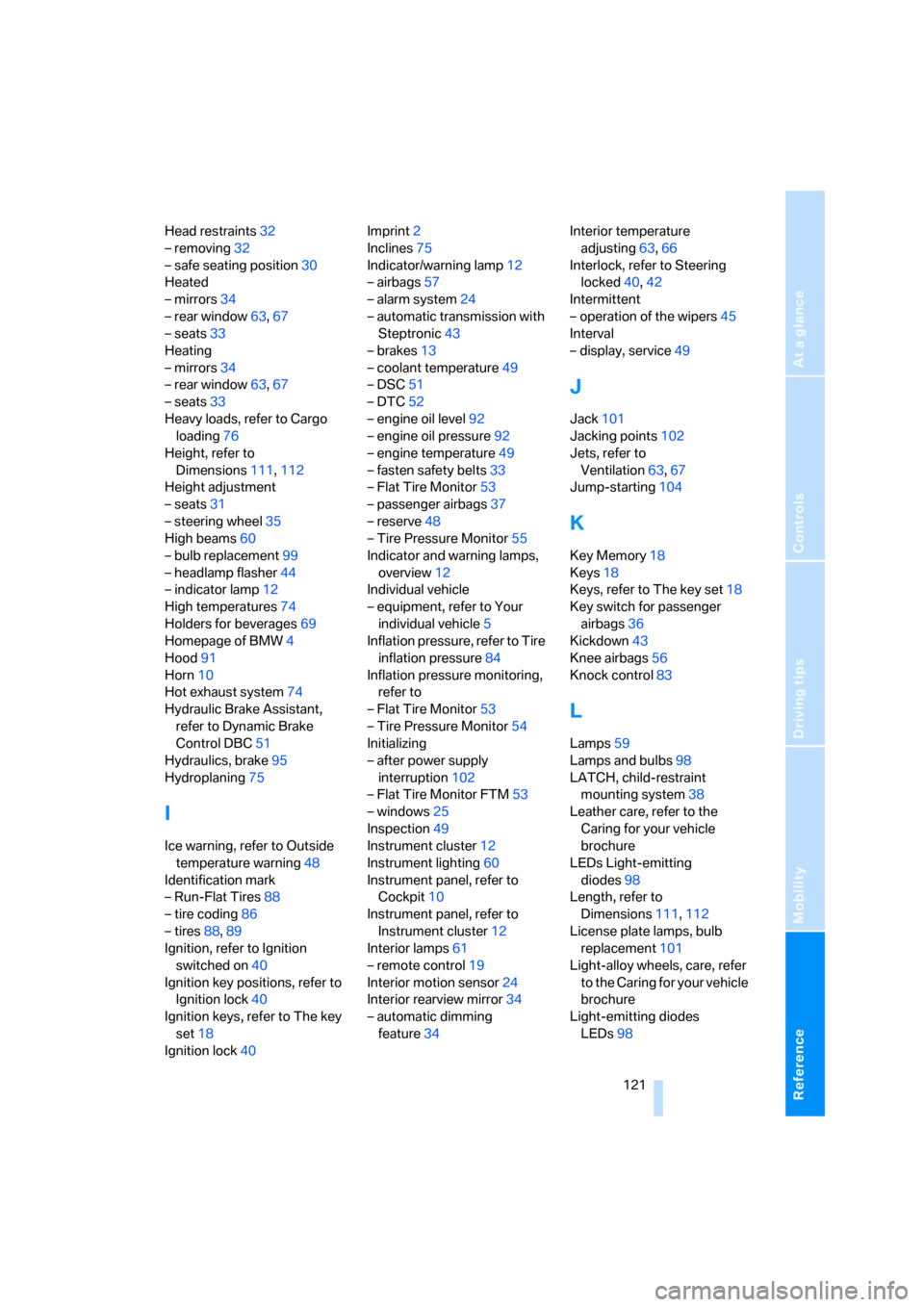
Reference
At a glance
Controls
Driving tips
Mobility
121
Head restraints32
– removing32
– safe seating position30
Heated
– mirrors34
– rear window63,67
– seats33
Heating
– mirrors34
– rear window63,67
– seats33
Heavy loads, refer to Cargo
loading76
Height, refer to
Dimensions111,112
Height adjustment
– seats31
– steering wheel35
High beams60
– bulb replacement99
– headlamp flasher44
– indicator lamp12
High temperatures74
Holders for beverages69
Homepage of BMW4
Hood91
Horn10
Hot exhaust system74
Hydraulic Brake Assistant,
refer to Dynamic Brake
Control DBC51
Hydraulics, brake95
Hydroplaning75
I
Ice warning, refer to Outside
temperature warning48
Identification mark
– Run-Flat Tires88
– tire coding86
– tires88,89
Ignition, refer to Ignition
switched on40
Ignition key positions, refer to
Ignition lock40
Ignition keys, refer to The key
set18
Ignition lock40Imprint2
Inclines75
Indicator/warning lamp12
– airbags57
– alarm system24
– automatic transmission with
Steptronic43
– brakes13
– coolant temperature49
– DSC51
– DTC52
– engine oil level92
– engine oil pressure92
– engine temperature49
– fasten safety belts33
– Flat Tire Monitor53
– passenger airbags37
– reserve48
– Tire Pressure Monitor55
Indicator and warning lamps,
overview12
Individual vehicle
– equipment, refer to Your
individual vehicle5
Inflation pressure, refer to Tire
inflation pressure84
Inflation pressure monitoring,
refer to
– Flat Tire Monitor53
– Tire Pressure Monitor54
Initializing
– after power supply
interruption102
– Flat Tire Monitor FTM53
– windows25
Inspection49
Instrument cluster12
Instrument lighting60
Instrument panel, refer to
Cockpit10
Instrument panel, refer to
Instrument cluster12
Interior lamps61
– remote control19
Interior motion sensor
24
Interior rearview mirror34
– automatic dimming
feature34Interior temperature
adjusting63,66
Interlock, refer to Steering
locked40,42
Intermittent
– operation of the wipers45
Interval
– display, service49
J
Jack101
Jacking points102
Jets, refer to
Ventilation63,67
Jump-starting104
K
Key Memory18
Keys18
Keys, refer to The key set18
Key switch for passenger
airbags36
Kickdown43
Knee airbags56
Knock control83
L
Lamps59
Lamps and bulbs98
LATCH, child-restraint
mounting system38
Leather care, refer to the
Caring for your vehicle
brochure
LEDs Light-emitting
diodes98
Length, refer to
Dimensions111,112
License plate lamps, bulb
replacement101
Light-alloy wheels, care, refer
to the Caring for your vehicle
brochure
Light-emitting diodes
LEDs98
Page 124 of 132
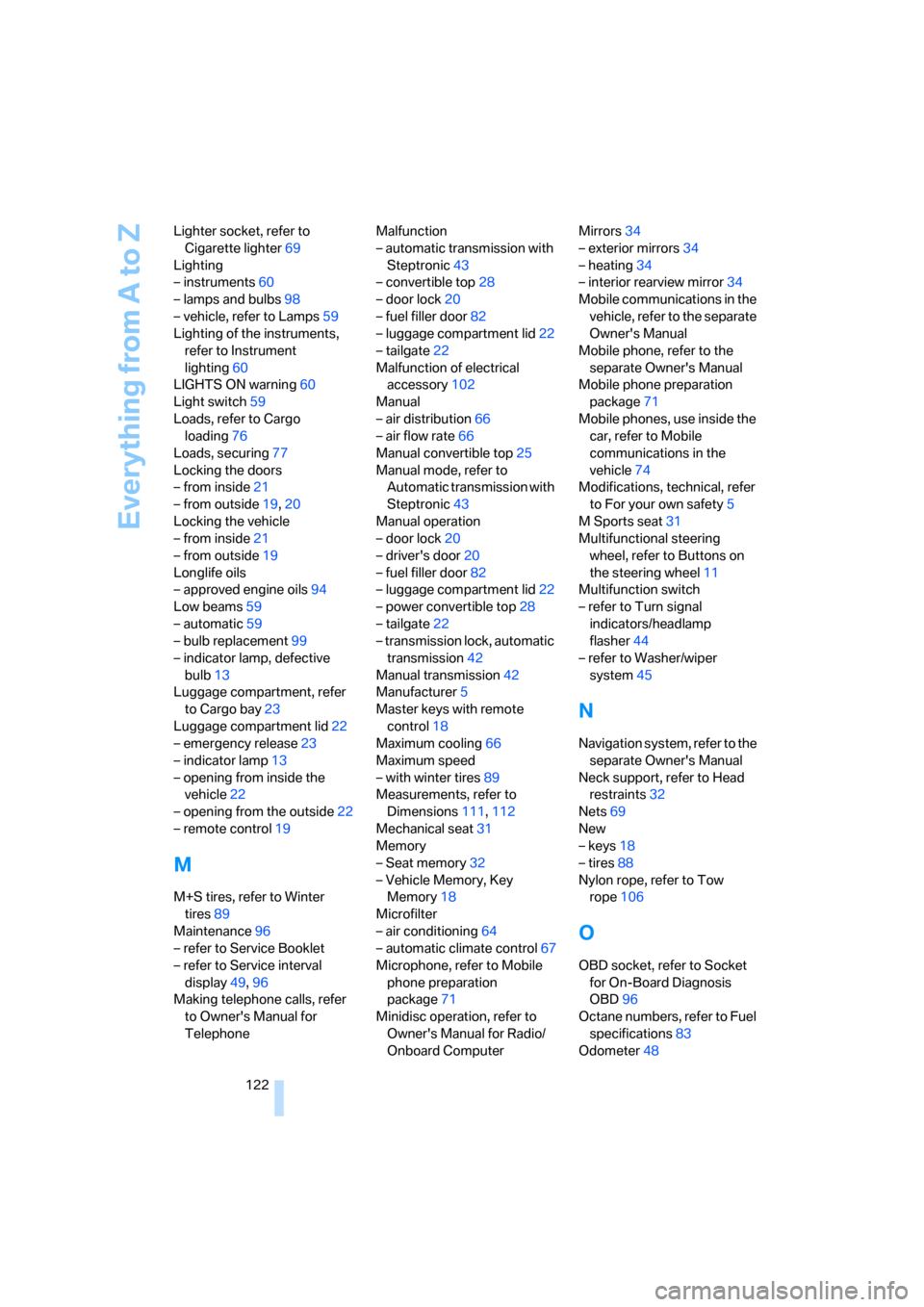
Everything from A to Z
122 Lighter socket, refer to
Cigarette lighter69
Lighting
– instruments60
– lamps and bulbs98
– vehicle, refer to Lamps59
Lighting of the instruments,
refer to Instrument
lighting60
LIGHTS ON warning60
Light switch59
Loads, refer to Cargo
loading76
Loads, securing77
Locking the doors
– from inside21
– from outside19,20
Locking the vehicle
– from inside21
– from outside19
Longlife oils
– approved engine oils94
Low beams59
– automatic59
– bulb replacement99
– indicator lamp, defective
bulb13
Luggage compartment, refer
to Cargo bay23
Luggage compartment lid22
– emergency release23
– indicator lamp13
– opening from inside the
vehicle22
– opening from the outside22
– remote control19
M
M+S tires, refer to Winter
tires89
Maintenance96
– refer to Service Booklet
– refer to Service interval
display49,96
Making telephone calls, refer
to Owner's Manual for
TelephoneMalfunction
– automatic transmission with
Steptronic43
– convertible top28
– door lock20
– fuel filler door82
– luggage compartment lid22
– tailgate22
Malfunction of electrical
accessory102
Manual
– air distribution66
– air flow rate66
Manual convertible top25
Manual mode, refer to
Automatic transmission with
Steptronic43
Manual operation
– door lock20
– driver's door20
– fuel filler door82
– luggage compartment lid22
– power convertible top28
– tailgate22
– transmission lock, automatic
transmission42
Manual transmission42
Manufacturer5
Master keys with remote
control18
Maximum cooling66
Maximum speed
– with winter tires89
Measurements, refer to
Dimensions111,112
Mechanical seat31
Memory
– Seat memory32
– Vehicle Memory, Key
Memory18
Microfilter
– air conditioning64
– automatic climate control67
Microphone, refer to Mobile
phone preparation
package71
Minidisc operation, refer to
Owner's Manual for Radio/
Onboard ComputerMirrors34
– exterior mirrors34
– heating34
– interior rearview mirror34
Mobile communications in the
vehicle, refer to the separate
Owner's Manual
Mobile phone, refer to the
separate Owner's Manual
Mobile phone preparation
package71
Mobile phones, use inside the
car, refer to Mobile
communications in the
vehicle74
Modifications, technical, refer
to For your own safety5
M Sports seat31
Multifunctional steering
wheel, refer to Buttons on
the steering wheel11
Multifunction switch
– refer to Turn signal
indicators/headlamp
flasher44
– refer to Washer/wiper
system45
N
Navigation system, refer to the
separate Owner's Manual
Neck support, refer to Head
restraints32
Nets69
New
– keys18
– tires88
Nylon rope, refer to Tow
rope106
O
OBD socket, refer to Socket
for On-Board Diagnosis
OBD96
Octane numbers, refer to Fuel
specifications83
Odometer48